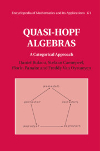- About MAA
- Membership
- MAA Publications
- Periodicals
- Blogs
- MAA Book Series
- MAA Press (an imprint of the AMS)
- MAA Notes
- MAA Reviews
- Mathematical Communication
- Information for Libraries
- Author Resources
- Advertise with MAA
- Meetings
- Competitions
- Programs
- Communities
- MAA Sections
- SIGMAA
- MAA Connect
- Students
- MAA Awards
- Awards Booklets
- Writing Awards
- Teaching Awards
- Service Awards
- Research Awards
- Lecture Awards
- Putnam Competition Individual and Team Winners
- D. E. Shaw Group AMC 8 Awards & Certificates
- Maryam Mirzakhani AMC 10 A Awards & Certificates
- Two Sigma AMC 10 B Awards & Certificates
- Jane Street AMC 12 A Awards & Certificates
- Akamai AMC 12 B Awards & Certificates
- High School Teachers
- News
You are here
Quasi-Hopf Algebras: A Categorical Approach

Publisher:
Cambridge University Press
Publication Date:
2019
Number of Pages:
544
Format:
Hardcover
Series:
Encyclopedia of Mathematics and its Applications
Price:
160.00
ISBN:
9781108427012
Category:
Monograph
[Reviewed by , on ]
Kevin Gerstle
07/28/2019
In modern mathematics, Hopf algebras serve as a powerful tool with applications to algebraic topology, algebraic geometry, and mathematical physics among other areas. Hopf algebras possess the structure of both an algebra and coalgebra, creating a bialgebra, as well as a linear map called the antipode analgous to the inversion mapping in a group. Drinfeld’s quasi-Hopf algebras generalize these structures by relaxing somewhat the underlying bialgebra structure – in particular, it need not be strictly coassociative. These quasi-Hopf algebras in turn allow for a wider variety of structures and applications than do Hopf algebras.
Quasi-Hopf Algebras: A Categorical Approach provides a comprehensive overview of the study of these mathematical structures that approaches them through the language of monoidal categories and functors. This book serves as a thorough reference source for topics related to the algebraic structure of quasi-Hopf algebras, their representations, and many key examples. By using the language of category theory throughout, this book presents its material very abstractly but in a way that allows results from the study of Hopf algebras to generalize to quasi-Hopf algebras. It does not delve deeply into applications of quasi-Hopf algebras outside of an algebraic setting; thus, while it may introduce topics such as the Yang-Baxter equation, it will not delve into their applications to other disciplines such as statistical mechanics.
This book is very well-organized and sets out to prove all of its major results meticulously at each step. Ultimately, there is little left to the readers to prove. This book also carefully defines all of its terms and thus is rather self-contained, though it is somewhat lacking in providing motivation to the reader. No prior knowledge is required other than a basic background in linear algebra and group theory, though prior knowledge of category theory and Hopf algebras strongly help with putting key topics into a larger context. Each chapter in this work ends with a brief history of its corresponding topics along with appropriate citations to their original works. This is quite helpful for understanding the history and significance of the associated algebraic structures and helps provide an overall picture that at times can be a struggle to comprehend. The book concludes with a strong bibliography and index.
Overall, I recommend this work for those with a strong background in category theory looking to learn algebraic results about quasi-Hopf algebras that can be transferable to other Hopf-type structures and monoidal categories. It is not recommended for those interested in the applications of quasi-Hopf structures to disciplines other than pure algebra or for those who are seeking to learn about category theory for the first time. For those with a solid background and intuition to category theory found for instance in Riehl’s Category Theory in Context and with a prior understanding of Hopf-type structures as found in Underwood’s Fundamentals of Hopf Algebras, this book provides an entirely self-contained collection of definitions, examples, theorems, and proofs written in great detail.
Kevin Gerstle is an assistant professor at Hillsdale College. His professional interests are in the study of representation theory and Brownian motion.
See the publisher's web page.
- Log in to post comments




